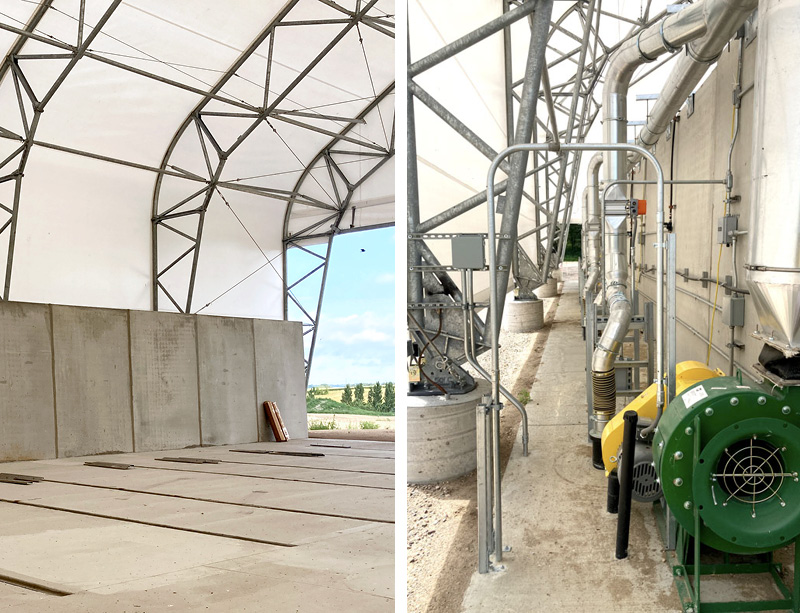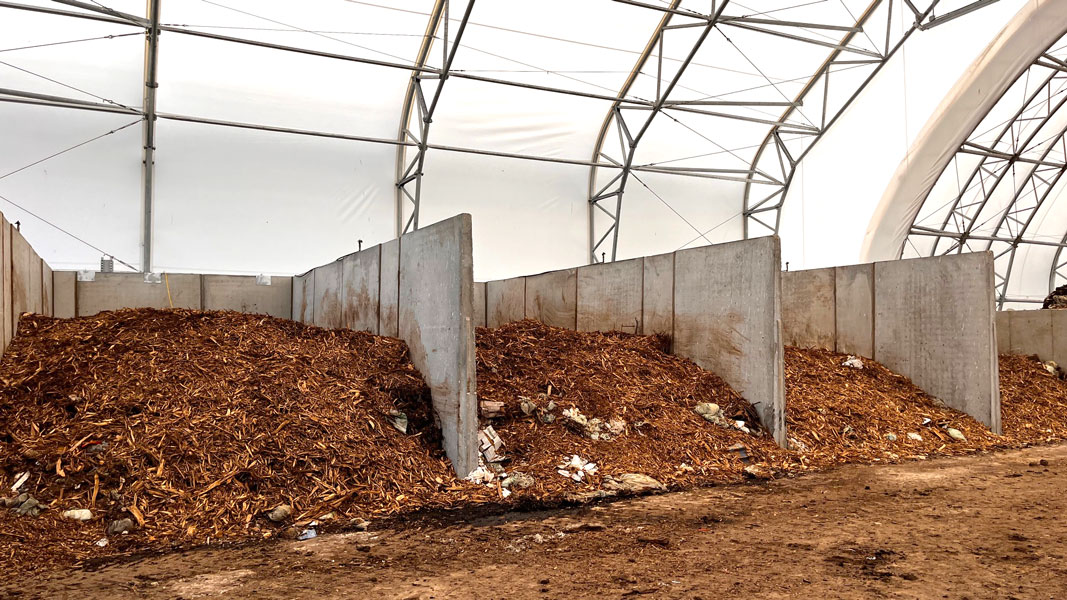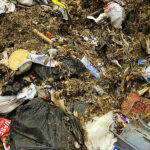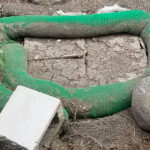Top: Four aerated bays with bunker walls are being used for composting and curing at the Pope/Douglas Glacial Ridge Composting Facility. Photo courtesy Engineered Compost Systems (ECS)
Nora Goldstein
Pope/Douglas Solid Waste Management (PDSWM), based in Alexandria, Minnesota, is a partnership created by Pope and Douglas Counties in 1983 to manage the municipal solid waste (MSW) stream generated in both counties. Now, approximately 80,000 tons/year of MSW are received from a 7-county area at PDSWM’s Mixed Waste Material Recovery Facility (MRF) and an adjoining Resource Recovery Facility (a waste-to-energy plant). The MRF preprocesses incoming trash via mechanical and human sorting to recover recyclable materials, including corrugated cardboard, ferrous and nonferrous metals, and wire. Hazardous wastes are also removed, and then the sorted MSW is combusted at the Resource Recovery Facility. In 2023, PDSWM expanded the existing Mixed Waste MRF into an Advanced Materials Recovery Facility designed to pull additional items out of the raw MSW stream as well as sort single stream recyclables collected curbside and at drop-off centers. This new MRF will be coming on-line at the end of first quarter 2025.
Food scraps and nonrecyclable paper comprise up to 30% of total MSW generated in Pope and Douglas Counties. There are several small yard trimmings composting sites in the two counties. PDSWM does not view food scraps as a beneficial input to the Resource Recovery Facility as it has a low BTU value and it “gums up the MRF conveyors and trommel,” notes Nathan Reinbold, Environmental Programs Manager. PDSWM received a Minnesota Pollution Control Agency (MPCA) Environmental Assistance Grant of $250,000 (covering years 2016-2018) to develop source separated organics (SSO) collection. The grant included funds for community awareness and outreach and development of transportation and composting capacity.
In 2017, a two-year pilot program was initiated to collect SSO from several schools, health care facilities and businesses in Pope and Douglas Counties. All food scraps, uncoated paper and BPI-certified compostable liner bags and products were accepted for the pilot. In addition, several residential food scrap drop-off sites were established.
“The pilot was not tremendously successful, so we discontinued it at the end of the two-year period and focused instead on expanding residential food scrap drop-off sites,” says Reinbold. “We now have nine drop-off sites throughout our service area.” Businesses and institutions that wanted to continue to divert SSO work with PDSWM on collection logistics. Carts and 2-cubic yard dumpsters are made available. About 80 to 100 establishments, including schools, are being serviced.
Organics Transfer Capacity
Collected organics during the pilot were brought to Tri-County Organics in St. Cloud (MN) — a 146-mile round trip — to be composted. The wear and tear on the collection vehicles, plus anticipation that PDSWM would ramp up organics diversion, resulted in a decision to first build an organics transfer facility, and then invest in SSO composting infrastructure at the same location. Initially, all collected SSO would be brought to the transfer site, consolidated, and hauled to Tri-County Organics. PDSWM began laying the groundwork for a SSO composting facility that would service its two counties, as well other counties in the region. Partnerships were formed with Grant, Stevens and Otter Tail counties to utilize the facility. Partner counties work with their local haulers to service SSO accounts.

The organics transfer station was built in 2020. It now serves primarily as the receiving area for SSO to be processed at the adjoining composting facility. Photo courtesy of PDSWM
The transfer station has capacity to accept up to 1,000 tons/year of SSO. It was built in 2020, funded in part by a MPCA Environmental Assistance Grant, and is located at PDSWM’s landfill for the ash from its waste-to-energy plant. Also located at the landfill site, which is near Hoffman (MN), is a Metal Recovery Facility to remove ferrous and nonferrous metal from the ash for recycling. Total construction costs for the organics transfer station were about $266,000; the site has a fabric structure with a concrete floor. To increase capture of SSO, PDSWM plans to adopt an ordinance that would require commercial and institutional generators to divert food scraps from the incinerator and is collaborating with the other county solid waste officers to adopt similar provisions.
Phased-In Composting Facility Design
For its SSO composting facility, PDSWM opted to use a phased-in capacity approach for facility design and construction, accommodating what was needed at the outset (first five years), and then anticipating 5- and 10-year increases in flow and facility capacity. Named the Glacial Ridge Composting Facility, the site has a permit from MPCA for 15,000 tons/year of SSO, yard trimmings, wood chips and other amendments. About 6,500 tons/year of SSO is anticipated to be processed once the composting facility has been fully built out.
PDSWM selected Engineered Compost Systems, Inc. (ECS) to develop a phased solution centered around high aeration rates and automated temperature control. Design criteria had to factor in:
- Processing challenging feedstocks
- Phased approach
- Function during cold winter climate (-30°F)
- Minimize odor
- Water management

Phase 1 is comprised of four positively aerated static pile zones on the east side of the fabric structure and four on the west side (above left). Aeration fans and piping shown on right. Photos courtesy of ECS
The facility abuts the transfer station structure and was sized to accommodate the active composting piles, with capacity to handle up to 6,000 tons of material. Enclosure of the active piles reduces the amount of contact water (leachate) that must be managed separately from storm water. Contact water is defined by Minnesota regulation as water that generally comes in contact with tipping and mixing areas (raw feedstocks) and active compost piles that have not met PFRP (Process to further reduce pathogens).
The initial facility (Phase 1) is designed to process 2,500 tons/year, including yard trimmings, and then doubling that amount over the next four to five years. Phase 1 is comprised of four positively aerated static pile (ASP) zones on the east side of the fabric structure and four on the other. Trench style aeration floors were installed to uniformly distribute air and capture leachate. The zones are designed for future conversion to reversing aeration that enables the system to recirculate air, which conserves thermal energy during the winter and allows cold piles to heat up much more rapidly. Below grade hardware was installed on the west side during the concrete pour, but the aeration ducts have not been connected.
The four zones on the east side serve as the active composting area and have bunker walls separating each zone. The other four zones are designated for curing. Because of the current SSO throughput (around 1,200 tons/year), only the east side with bunker walls has been used for the active and curing phases. The Phase 1 build-out has capacity to manage up to 6,000 tons/year by using the non-bunkered zones on the west side and outside windrows for final curing.
The Glacial Ridge facility began composting in 2022. In 2023, its first full year of operation, it received 500 to 600 tons of SSO and an equivalent amount of wood chips and yard trimmings. The initial mix is comprised generally of one-third SSO, one-third wood chips and one-third yard trimmings.
Phase 2 adds eight more zones and includes ductwork to enable reversing and recirculating aeration. It will require expanding the pad space and covered area and includes an additional four zones to the east and west sides, for a total of 16 zones of active composting capacity. The zones on the east side are planned to be upgraded to reversing/recirculating aeration. There is adequate land area at the facility to expand if and when needed.
A total of $2.145 million in state and local matching bonds was used to construct the compost processing building and operations office. While the lowest capital cost in terms of construction would be to purchase and install the entire system at once, the reality for PDSWM is that it would be paying for infrastructure long before it would be using it. Instead, PDSWM matched its capital investment to the expected organics load. Including the below grade aeration infrastructure for the four zones on the west side of the building was a cost savings to PDSWM as it enabled the contractor to pour the entire floor and construct the building in a single mobilization.
Compost Markets
An incentive to own and operate its own SSO composting facility was to increase the amount of compost available locally, says Reinbold. “Our goal is to develop county compost use requirements, as well as to become a compost supplier to the Minnesota Department of Transportation for highway projects. Longer term, we would like to bag the compost for sale at local garden centers, as well as offer rental of a top-spreader to households for turf application.”
As part of its air permit from MPCA, PDSWM conducts waste sorts every five years. Findings from the 2024 waste sort were not available prior to this article being written. The 2019 waste sort found that food waste comprised 14.7% of the sorted MSW. “For the 2024 MSW sort, we included additional parameters for how we track food organics in the waste stream,” explains Reinbold. “We added a category for ‘accessible’ food waste, defined as ‘loose’ or ‘containerized’. We are anticipating the percentage of accessible loose food in the garbage stream to be more like 12%.” The anticipated findings help build the case for PDSWM to pass an ordinance requiring commercial and institutional generators to source separate their food scraps for composting.













